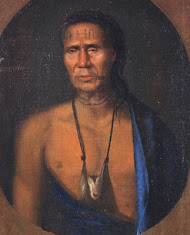The real historical Native Americans who appear in the Northkill Amish Series.
Custaloga. Also known as Packanke. A chief of the
Delaware (Lenape) tribe in the mid-18th century and a member of the Wolf
division through his mother. He built a sizeable village with his band at
the confluence of French Creek and North Deer Creek (present-day town of
Carlton) in Mercer County, Pennsylvania. Known as Custaloga’s Town, this became
his principal seat. He also established a village known as Cussewago along
French Creek at the present site of Meadville in Crawford County,
Pennsylvania. Custaloga’s name first appeared in western Pennsylvania’s
history in George Washington‘s 1753 Journal. When the 21 year-old
Washington arrived at Fort Machault at Venango (now Franklin,
Pennsylvania), Custaloga was the keeper of his nation's wampum under
Chief Shingas. In 1763 Custaloga moved his band into the Ohio
Territory. Despite professions of loyalty to the British, he became one of
the prime conspirators in Pontiac's Rebellion. After 1778 there is little
mention of him in contemporary records, and he may have died as early
as 1775.
Killbuck. Lanape name, Bemino. A son of Netawatwees, at one time principal chief of the Lenape, he was a renowned medicine man and war leader of Lenape and Shawnee warriors during the French and Indian War. Bemino lived with his people in what is now eastern Ohio and during the war allied with the French against British settlers. He led his warrior bands in attacks mostly in the upper Potomac River watershed, in what is now the Eastern Panhandle of West Virginia. His son Gelelemend (also known as John Killbuck Jr.), was a Delaware chief during the American Revolutionary War.
Shingas (c. 1740–1764). A member of the Lenape Turkey division, or phratry, and leader of his people in the Ohio Country, Shingas was a noted American Indian warrior on the western frontier during the French and Indian War. Like most of the Lenape, he stayed neutral early in the conflict but as the conflict spread eventually took part in the brutal backcountry war with the British colonies, leading raids deep into the Pennsylvania and Virginia settlements. An implacable foe in battle, he became known as Shingas the Terrible even though he never treated prisoners with cruelty. When a peace faction led by his brother Tamaque began to gain influence, Shingas joined their efforts but remained in the background, fearing retribution because of his actions in the war. Like Tamaque, he came under the influence of Moravian missionaries such as Christian Frederick Post.
When the British built Fort Pitt on the ruins of Fort Du Quesne in violation of their promises, a coalition of tribes rebelled in 1763 in what became known as the Pontiac-Guyasuta War. It's uncertain whether Shingas participated in the renewed conflict. He and Tamaque tried to convince the British to withdraw from the Forks, but their efforts came to nothing when an expedition led by Colonel Henry Bouquet broke through the siege to relieve the fort. Both Shingas and Tamaque, who advocated for accommodation with the British, lost influence with their people with the rise of the Lenape Prophet Neolin, and around 1764 Shingas disappeared from the historical record.
Tamaque. Also known as Beaver or King Beaver. A member of the Turkey division and a nephew of the great Lenape leader Sassoonan. When Sassoonan died in 1747, Tamaque and his two brothers, Pisquetomen and Shingas, assumed important leadership roles. While Shingas earned a reputation as a fearsome war captain, Tamaqua became equally influential as a diplomat among the Lenape and became known as an advocate for peace. Tthere is little evidence that he took part in the Indian raids that devastated Pennsylvania during the French and Indian War. His and Shingas's brother Pisquetomen was responsible for Christian Frederick Post on his peace mission to the Lenape for Governor Denney and brought him to Tamaque at Kuskuskies in the summer of 1758. He and Tamaque helped to negotiate the Treaty of Easton, which effectively ended the war for the Lenape and enabled British General John Forbes to capture Fort Du Quesne without interference from local Indians.
During Pontiac’s Uprising Tamaque worked to restore peace by urging the tribes to give up their prisoners, and in the following years his name appears many times in documents relating to treaties and conferences between the British and the Indians. He came under the influence of Moravians missionaries such as Christian Frederick Post and invited them to establish missions among the Lenape in eastern Ohio. He converted to Christianity shortly before his death in 1771.
Teedyuscung. A member of the Turtle division born at
Trenton, NJ, about 1705, the son of a Lenape sachem called Captain John Harris.
He moved to the Forks of the Delaware about 1730 and eventually settled
at Wyoming. He was never a sachem, but because of his unusual abilities and
influence among the Indians in the Susquehanna Valley, the English considered
him to be a king of the Lenape. Consequently he was involved in many
negotiations, conferences, and treaties between the tribes and the English and
worked to establish peace. He became attracted to the Moravian
missionaries, and his wife was baptized and joined their community. He
finally also converted and was baptized, but after a time he left the
community. Tragically, he died on April 16,1763, when his house was set
on fire by some of his enemies while he lay drunk inside.
Teedyuscung
White Eyes. A member of the Turtle division. He served as a Lenape captain during the French and Indian War and the Revolution. He was a personal friend of George Washington and in 1778 received the rank of colonel in the American army. He died in Pittsburg.

